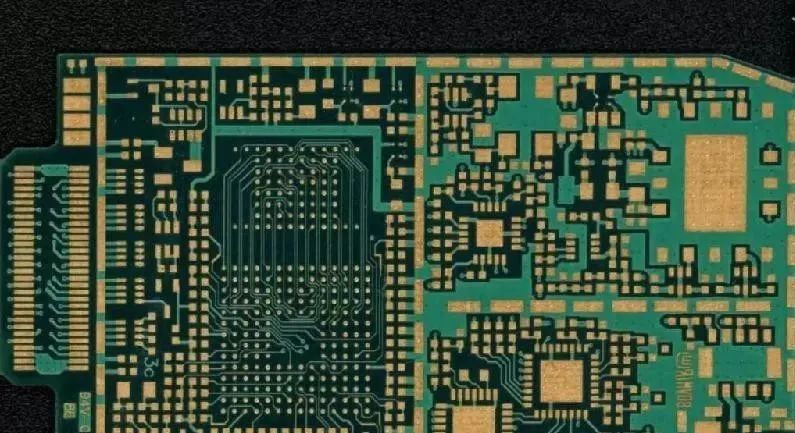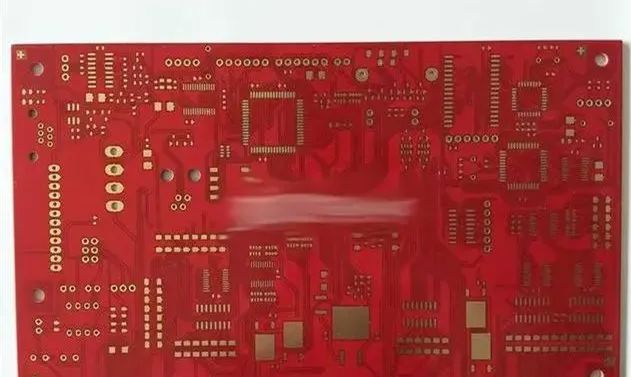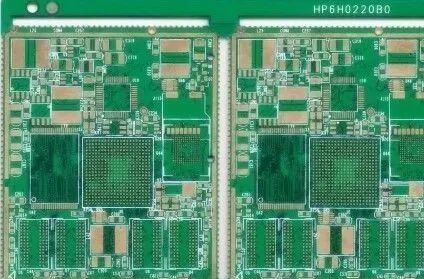1. PCB Surface Treatment
The surface treatment processes for PCBs include: anti-oxidation, tin spraying, lead-free tin spraying, immersion gold, immersion tin, immersion silver, hard gold plating, full board gold plating, gold fingers, nickel-palladium gold OSP, etc. The main requirements are: low cost, good solderability, strict storage conditions, short time, environmentally friendly processes, good soldering, and flatness. Tin spraying: Tin-sprayed boards are generally multilayer (4-46 layers) high-precision PCB prototypes, which have been adopted by many large domestic communication, computer, medical equipment, and aerospace companies and research institutions. Gold fingers (connecting fingers) are the connecting components between memory modules and memory slots, through which all signals are transmitted. Gold fingers consist of numerous gold-colored conductive contacts, and because their surface is gold-plated and the contacts are arranged like fingers, they are called “gold fingers.” Gold finger boards require either gold plating or immersion gold. Gold fingers are actually a layer of gold applied over a copper-clad board through a special process, due to gold’s strong anti-oxidation properties and excellent conductivity. However, due to the high cost of gold, many memory modules now use tin plating instead. Since the 1990s, tin materials have become widespread, and currently, the “gold fingers” of motherboards, memory, and graphics cards are almost all made of tin, with only some high-performance server/workstation components continuing to use gold plating, which is naturally expensive.
Gold fingers (connecting fingers) are the connecting components between memory modules and memory slots, through which all signals are transmitted. Gold fingers consist of numerous gold-colored conductive contacts, and because their surface is gold-plated and the contacts are arranged like fingers, they are called “gold fingers.” Gold finger boards require either gold plating or immersion gold. Gold fingers are actually a layer of gold applied over a copper-clad board through a special process, due to gold’s strong anti-oxidation properties and excellent conductivity. However, due to the high cost of gold, many memory modules now use tin plating instead. Since the 1990s, tin materials have become widespread, and currently, the “gold fingers” of motherboards, memory, and graphics cards are almost all made of tin, with only some high-performance server/workstation components continuing to use gold plating, which is naturally expensive.
2. Differences Between Gold Plating and Immersion Gold Processes
Immersion gold uses a chemical deposition method, generating a layer of plating through a chemical oxidation-reduction reaction, generally resulting in a thicker layer. It is a type of chemical nickel-gold deposition method that can achieve a thicker gold layer.
Gold plating uses an electrolytic principle, also known as electroplating. Most other metal surface treatments also use electroplating. In actual product applications, 90% of gold boards are immersion gold boards, as the poor solderability of gold-plated boards is a fatal flaw, which is also the direct reason many companies abandon the gold plating process! The immersion gold process deposits a stable color on the printed circuit surface, with good brightness, a flat coating, and good solderability of the nickel-gold layer. It can be divided into four stages: pre-treatment (degreasing, micro-etching, activation, post-dipping), nickel deposition, gold deposition, and post-treatment (waste gold solution washing, DI water washing, drying). The thickness of immersion gold ranges from 0.025 to 0.1um.Gold is used for PCB surface treatment because of its strong conductivity, good anti-oxidation properties, and long lifespan, typically applied in keypads, gold finger boards, etc. The fundamental difference between gold-plated and immersion gold boards is that gold plating is hard gold (wear-resistant), while immersion gold is soft gold (not wear-resistant).

1. The crystal structures formed by immersion gold and gold plating are different; immersion gold is much thicker than gold plating and appears more yellow (this is one way to distinguish between gold plating and immersion gold), while gold plating has a slightly whitish hue (due to nickel’s color).
2. The crystal structures formed by immersion gold and gold plating are different; immersion gold is relatively easier to solder and does not cause soldering defects. The stress of immersion gold boards is easier to control, which is more beneficial for bonding products. However, because immersion gold is softer than gold plating, immersion gold boards are not wear-resistant (a disadvantage of immersion gold boards).
3. Immersion gold boards only have nickel-gold on the pads, and in the skin effect, signal transmission occurs in the copper layer without affecting the signal.
4. Immersion gold has a denser crystal structure than gold plating, making it less prone to oxidation.
5. As the precision requirements for PCB processing increase, with line widths and spacings below 0.1mm, gold plating is more likely to cause gold wire short circuits. Immersion gold boards only have nickel-gold on the pads, so they are less likely to cause gold wire short circuits.6. Immersion gold boards only have nickel-gold on the pads, so the bonding of the solder mask to the copper layer is more secure. Engineering compensation will not affect the spacing.7. For boards with high requirements, good flatness is required, and immersion gold is generally used, as immersion gold boards do not exhibit black pad phenomena after assembly. The flatness and lifespan of immersion gold boards are better than those of gold-plated boards.

3. Why Use Gold Plated Boards
With the increasing integration of ICs, the number of IC pins is also becoming denser. The vertical tin spraying process makes it difficult to flatten fine pads, which poses challenges for SMT assembly; additionally, the shelf life of tin-sprayed boards is very short. Gold-plated boards solve these problems:
1. For surface mount technology, especially for 0603 and 0402 ultra-small surface mounts, the flatness of the pads directly affects the quality of the solder paste printing process, which has a decisive impact on the quality of subsequent reflow soldering. Therefore, full board gold plating is often seen in high-density and ultra-small surface mount processes.
2. During the trial production phase, due to factors such as component procurement, boards often do not get soldered immediately upon arrival, but may have to wait several weeks or even months before use. Gold-plated boards have a shelf life many times longer than lead-tin alloys, so they are preferred. Moreover, the cost of gold PCBs during the trial phase is not significantly different from that of lead-tin alloy boards. However, as routing becomes denser, with line widths and spacings down to 3-4 MIL, this leads to gold wire short circuit issues: as signal frequencies increase, the impact of skin effect on signal quality during transmission through multiple plated layers becomes more pronounced. The skin effect refers to the phenomenon where high-frequency AC current tends to flow near the surface of conductors. According to calculations, skin depth is related to frequency.
4. Why Use Immersion Gold Boards
To address the issues with gold-plated boards, immersion gold PCBs have the following characteristics:1. Because the crystal structures formed by immersion gold and gold plating are different, immersion gold appears more yellow than gold plating, which is more satisfying to customers.2. Because the crystal structures formed by immersion gold and gold plating are different, immersion gold is easier to solder than gold plating, preventing soldering defects that could lead to customer complaints.3. Because immersion gold boards only have nickel-gold on the pads, signal transmission in the skin effect occurs in the copper layer without affecting the signal.4. Because immersion gold has a denser crystal structure than gold plating, it is less prone to oxidation.5. Because immersion gold boards only have nickel-gold on the pads, they do not cause gold wire micro-short circuits.6. Because immersion gold boards only have nickel-gold on the pads, the bonding of the solder mask to the copper layer is more secure.7. Engineering compensation will not affect the spacing.8. Because the crystal structures formed by immersion gold and gold plating are different, the stress of immersion gold boards is easier to control, which is more beneficial for bonding products. However, because immersion gold is softer than gold plating, immersion gold boards are not wear-resistant.9. The flatness and shelf life of immersion gold boards are as good as those of gold-plated boards.Therefore, most factories currently use immersion gold processes to produce gold boards. However, the immersion gold process is more expensive than the gold plating process (due to higher gold content), so there are still many low-cost products that use gold plating processes (such as remote control boards, toy boards).
5. Immersion Gold Boards vs. Gold Plated Boards
In fact, gold plating processes can be divided into two types: one is electroplated gold, and the other is immersion gold. For gold plating processes, the effect of tin application is significantly reduced, while immersion gold has a better tin application effect; unless the manufacturer requires bonding, most manufacturers will choose the immersion gold process! Generally, the common surface treatments for PCBs are as follows: gold plating (electroplated gold, immersion gold), silver plating, OSP, tin spraying (lead and lead-free), which are mainly targeted at FR-4 or CEM-3 boards. Paper-based materials also have a surface treatment method of coating with rosin; poor tin application (poor soldering) can be attributed to several reasons if we exclude issues related to solder paste production and material processes.Here, we only discuss PCB issues, which can be attributed to the following reasons:1. During PCB printing, whether there is an oil film on the PAN position, which can block the tin application effect; this can be verified through a tin float test.2. Whether the PAN position’s lubrication meets design requirements, meaning whether the pad design can sufficiently support the components.
3. Whether the pads have been contaminated, which can be determined through ionic contamination testing;

The advantages and disadvantages of various surface treatment methods each have their strengths and weaknesses! In terms of gold plating, it allows PCBs to be stored for a longer time and is less affected by external environmental humidity and temperature changes (compared to other surface treatments), generally lasting about a year; tin spraying surface treatment is next, followed by OSP. These two surface treatments require careful attention to storage time under environmental humidity and temperature. Generally, immersion silver surface treatment is somewhat different, is more expensive, and has stricter storage conditions, requiring packaging with sulfur-free paper! Moreover, the storage time is around three months! In terms of tin application effects, immersion gold, OSP, and tin spraying are actually quite similar!